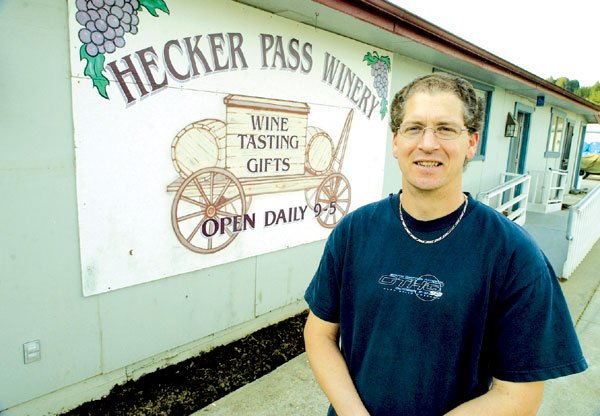More than a year after their association folded amid a minor
bankruptcy scandal, local wine growers are still figuring out how
to come together in common cause to promote the region’s
business.
Gilroy – More than a year after their association folded amid a minor bankruptcy scandal, local wine growers are still figuring out how to come together in common cause to promote the region’s business.
Threatened with a lawsuit from its one paid employee, the Santa Clara Valley Wine Growers’ Association declared bankruptcy in October 2003, effectively ending the nonprofit’s existence. Since then, a number of areas vintners have stayed together in a loose collective, but their activities have been limited.
“We’re taking baby steps to reform our association,” said Gene Guglielmo, of Emilio Guglielmo Winery in Morgan Hill.
Santa Clara Valley is actually the state’s oldest wine producing region, with a history reaching back to the 1850’s that predates the more prestigious growers in Napa and on the central coast. Guglielmo Winery dates back to 1925. The Wine Growers’ Association began in 1947.
Dave Muret, who until last year was communications director for La Rochelle Winery in San Jose, a member of the Association, said Monday that small wineries need to band together for promotion and advertising in order to thrive.
“When you’re a boutique winery, you don’t have any advertising budget,” Muret said. “An association gives them more clout and notice than they get as individuals.”
Local winery owners don’t dispute that, but none of them seem eager to rush into the same kind of association they had previously. Carlo Fortino, of Hecker Pass Winery, said that busy schedules and bad memories of the way the Association disbanded have changed many grower’s outlook on working together.
“Everyone’s so busy with their own thing, It’s takes time to get everyone back to the table,” Fortino said. “The bankruptcy was negative, so everyone said ‘let’s just forget about it for a while,’ but everything else was positive, and it’s important that we get something going again.”
But nothing really has changed. Last April’s annual barbecue and tasting event at Casa de Fruta went off as planned, and another is scheduled for this April. About 15 wineries kicked in $500 each to print a promotional brochure and map of the region. And if anything, business has improved.
“Life’s changed very little since the bankruptcy,” said Dave Heiber, wine maker at Sarah’s Vineyard on Hecker Pass Highway.
Alex Larson, who owns Rapazzini Winery with his brother, said he doesn’t see the need for a return to a formal organization.
“We used to do a lot of informational kind of things at the county fair and that was nice,” Larson said. “But as far as forming an association, I think we just need to stay together as friends, have events and invite the public to taste our wines.”
Many growers were disappointed by the Association’s decision to hire Valerie Brockbank, the executive director who eventually filed suit over her working conditions. Brockbank’s hiring caused a ten-fold increase in dues, and growers didn’t feel the benefits were worth it. They say a lot of promised promotion and exposure never happened.
Fortino said that any new collective will likely be a pay-as-you-go operation. Rather than paying dues, members will underwrite projects and events as they happen. He said the best thing for growers would be to hold more affairs at the wineries, much like annual Passport Weekend hosted by the Association.
“When you go to a festival, you get a little table and can only take three different wines,” Fortino said. “If I have can stay here, I can serve hors d’oeuvres and all 16 of my wines, and really show people my winery.”
And Fortino and other vintners agreed that the Internet has changed their marketing needs.
“It used to be that people got their information about wine one-on-one, in a very personal way,” Larson said. “Now with the Internet, you can get all the information you want in one place.”
Fortino said that any future collective will have a Web site, but doesn’t expect its members to consider it a priority.
“It’s very expensive,” he said. “You need to have a page for each winery, and a shopping cart. Why would you want to invest a lot in a generic Web site when you have your own beautiful site that you’ve spent $5,000 on?”
Larson said that membership in a state wine association keep local vintners apprised of legal and land use issues. Wine growers are most interested in an organization as a way to stay connected with one another and stay informed about what’s going on locally. Also, wine growers’ meeting tend to be great social occasions.
To that end, several local wineries have gotten involved with another collective started by Todd and Alexia Johnson, amateur growers in Morgan Hill. The Johnson’s held their first meeting last October and attracted a 40-strong crowd.
“We’ve had a great response,” Johnson said. “I think having both facets – growers and wine makers – went hand in hand. My goal was to establish a group here that can help one another grow better grapes, make better wine and help the region get more recognition.”
The Johnson’s, who grow about 1,000 vines and bottle under the name Monteverdi, do not plan to have a dues-based membership. There’s will be a strictly networking organization that will allow amateur growers to learn from commercial growers, and commercial growers to raise their profile. Their last meeting was held at the Guglielmo Winery.
“What happened with the Association was an unfortunate glitch in our history,” Guglielmo said, “but we have a lot to be proud of and a lot to promote.”















